A Dutch Treat
The Netherlands, June 29-July 5
We arrived at the Newcastle ferry terminal June 28 not knowing what to expect, for our previous experience between Britain and the Continent had been limited to 45-minute runs between Dover and Calais. Happily, “The King of Scandinavia” was much like a cruise ship with restaurants, bars, movie theatres, a casino, and modern bathroom-equipped staterooms a bit larger than what one would find in a Pullman car. We were almost sorry to leave 17 hours later when the ship (it’s hard to call it a ferry) docked at IJmuiden, the port for Amsterdam.
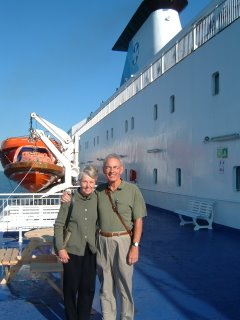
On the King of Scandinavia
Since we had arrived in the early morning, we made the most of our day by driving eastward to the Het Loo Palace close to the center of the Netherlands. Truth to tell, neither of us had previously heard of Het Loo, which was begun by Prince William of Orange and Princess Mary Stuart in the second half of the 17th Century before they became British monarchs and founded a college in Virginia. Now a museum, the building, its furnishings and its magnificent gardens have recently been restored to their original designs. The complex rivals anything we saw in Britain.
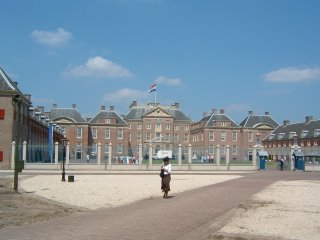
Het Loo Palace
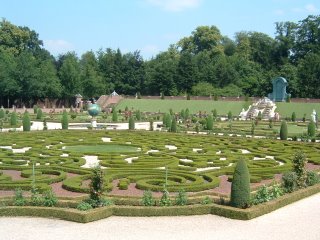
Gardens at Het Loo
Our first four nights in the Netherlands were spent in Noordwijk aan Zee, a vacation community between Amsterdam and The Hague on the North Sea. In between sightseeing excursions we rented bikes to ride on trails along the coastal dunes and spent one afternoon on the Noordwijk beach, where the temperature was over 30 degrees. Always an interested student of local social customs, Todd found that topless sunbathing is accepted on the Dutch coast but is far from common; he also observed that age is not a good predictor of the probability of participation.
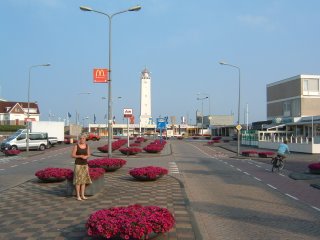
Noordwijk aan Zee
2006 is the 400th anniversary of Rembrandt’s birth, and the Dutch are celebrating. Outside the Amsterdam Rijksmuseum is a large poster with the master’s head and the caption “400? Moi?” Inside, much of the total collection was closed for the building’s renovation, but one wing had all the museum’s great Rembrandt paintings on display, including “The Night Watch.” The Mauritshuis museum in the Hague, which we visited later, also did itself proud with a more intimately presented collection featuring “The Anatomy Lesson,” although we were also impressed with Vermeer’s “Girl with the Pearl Earring” and works by Jan Steen. As a break from serious art viewing, we spent three wonderful hours at The Hague’s Madurodam, the model village with miniature reconstructions of the country’s most prominent buildings.

Rijksmuseum, Amsterdam
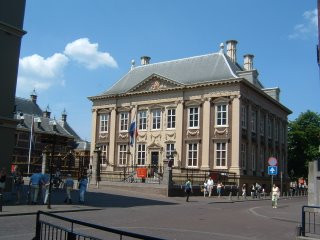
Mauritshuis, The Hague

Rembrandt poster outside Mauritshuis, The Hague
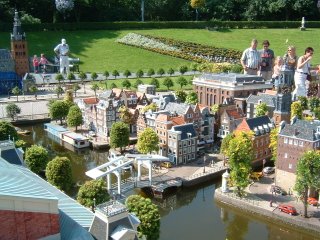
Madurodam, The Hague
We did a considerable amount of walking in Amsterdam to appreciate its architecture. Possibly the prettiest area is the Begijnhof, an enclave of very old houses that have for centuries housed members of a Catholic women’s order devoted to charitable works, plus a formerly secret church where Catholics worshipped before religious emancipation. A visit to the enormously crowded Van Gogh Museum was draining, but we still had enough juice at the end of the day to tour the flower market, still in full swing, where the prices were astoundingly low for such high quality blooms.

Begijnhof

Flower stalls on the canal
To round out our homage to Rembrandt, we visited Leiden, his birthplace, and took a canal tour of this very accessible city. We were amused by the following sign that conveys the importance placed by the Dutch on “Appeltaart”—with justification, we would quickly add.
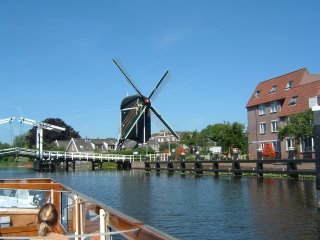
Leiden
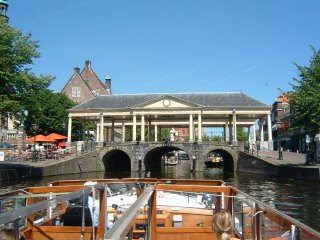
Old corn market, Leiden
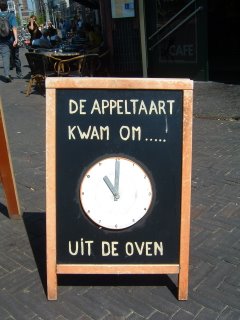
Appeltaart's ready!
We decided to chill out at the end of our visit by spending a couple of days in Norg, an upscale village in Drenthe Province in the northern Netherlands, which is a popular summer Dutch vacation spot although we seemed to be the only foreigners in town. Like our excellent small hotel in Nordwijk, the Hotel Karsten was picked from the Michelin red guide and proved to be at least as good with wonderful food and charming accommodations located on the edge of the village square. The Dutch apparently come here to bicycle, and we followed their example, admiring the half-thatched and half-tiled roofed houses typical of Drenthe and watching haying operations from the bike path. A special goal, finally reached, was one of the many Dutch “hunebeden,” Neolithic burial sites contemporaneous with Stonehenge but with much smaller stones.
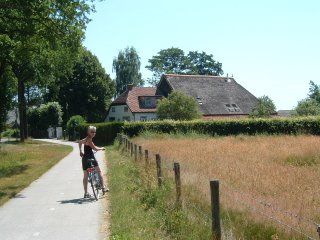
Half-thatched, half-tiled house near Norg
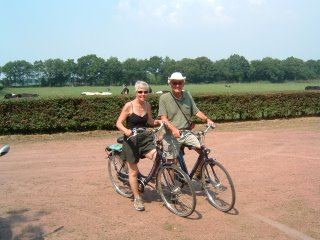
Near the bike path
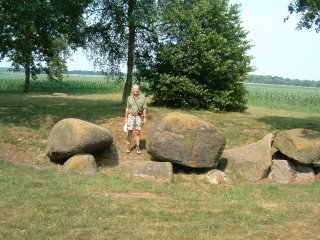
Hunebed
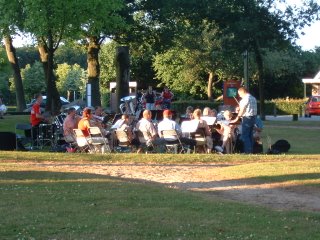
Not the Sun Valley Summer Symphony! (Norg municipal symphonic band)
Finally, we must add a few words about bicycling in the Netherlands, an activity apparently pursued by anyone able to push a pedal on bike paths almost as numerous as highways. The following photo, taken at the Leiden railway station, will give you some idea of the density of bicycle traffic in this country—but we should note that this two-story rack had a counterpart to the left out of the picture to accommodate more bikes of students and other train commuters to Leiden. There are some US-style road bikes, but the great majority of bicycles have fenders front and back, 5-7 gears, a cargo rack, a bell, a headlight, and a built-in lock on the back wheel. As you can imagine, such a contraption is hardly light. One would think that with so many bicycles, theft would not be a problem, but the Leiden University student in the picture told us that she had had two bikes stolen, even with the wheel lock secured, before she started to chain her bicycle to the rack.

Bicycle storage at Leiden station

0 Comments:
Post a Comment
<< Home